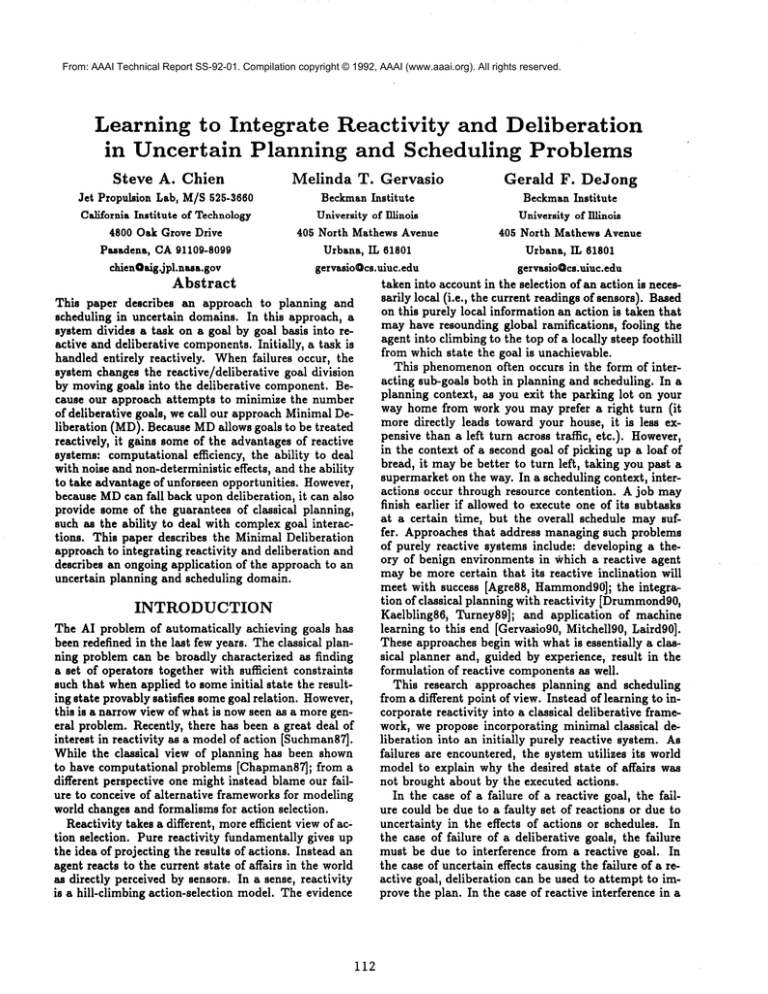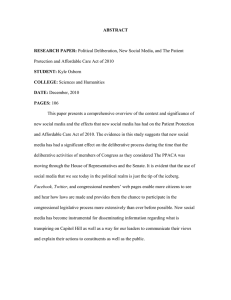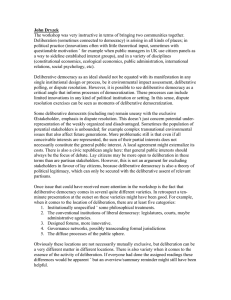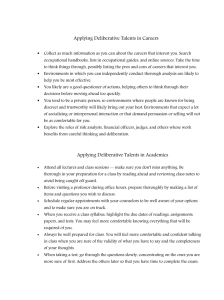
From: AAAI Technical Report SS-92-01. Compilation copyright © 1992, AAAI (www.aaai.org). All rights reserved.
Learning to Integrate
Reactivity
and Deliberation
in Uncertain
Planning and Scheduling
Problems
Steve
A. Chien
Melinda
T. Gervasio
Gerald
F. DeJong
Jet Propulsion Lab, M/S525-3680
BeckmanInstitute
BeckmanInstitute
California Institute of Technology
University of lll~nols
University of IIHnois
4800 Oak Grove Drive
405 North Mathews Avenue
405 North Mathews Avenue
Pasadena, CA91109-8099
Urbana,IL 61801
Urbana,IL 61801
chienQaig.jpl.nasa.gov
gervasioQcs.uiuc.edu
gervasioQcs.uiuc.edu
Abstract
taken into account in the selection of an action is necessarily local (i.e., the current readings of sensors). Based
This paper describes an approach to planning and
on this purely local information an action is taken that
scheduling in uncertain domains. In this approach, a
may have resounding global ramifications, fooling the
system divides a task on a goal by goal basis into reagent into climbing to the top of a locally steep foothill
active and deliberative components.Initially, a task is
from which state the goal is unachievable.
handled entirely reactively. Whenfailures occur, the
This phenomenonoften occurs in the form of intersystem changes the reactive/deliberative
goal division
acting
sub-goals both in planning and scheduling. In a
by moving goals into the deliberative component. Beplanning
context, as you exit the parking lot on your
cause our approach attempts to minimize the number
way home from work you may prefer a right turn (it
of deliberative goals, we call our approach MinimalDemore directly leads toward your house, it is less exliberation (MD). Because MDallows goals to be treated
pensive than a left turn across traffic, etc.). However,
reactively, it gains someof the advantages of reactive
in the context of a second goal of picking up a loaf of
systems: computational efficiency, the ability to deal
bread, it may be better to turn left, taking you past a
with noise and non-deterministic effects, and the ability
supermarket
on the way. In a scheduling context, interto take advantage of unforseen opportunities. However,
actions
occur
through resource contention. A job may
because MDcan fall back upon deliberation, it can also
finish
earlier
if allowed to execute one of its subtasks
provide some of the guarantees of classical planning,
at a certain time, but the overall schedule may sufsuch as the ability to deal with complex goal interacfer. Approaches that address managing such problems
tions. This paper describes the Minimal Deliberation
of purely reactive systems include: developing a theapproach to integrating reactivity and deliberation and
ory of benign environments in which a reactive agent
describes an ongoing application of the approach to an
may be more certain that its reactive inclination will
uncertain planning and scheduling domain.
meet with success [Agre88, Hammondg0];the integration of classical planning with reactivity [Drummondg0,
INTRODUCTION
Kaelbling86, Turney89]; and application of machine
The AI problem of automatically achieving goals has
learning to this end [Gervasiog0, Mitchellg0, Lairdg0].
been redefined in the last few years. The classical planThese approaches begin with what is essentially a clasning problem can be broadly characterized as finding
sical planner and, guided by experience, result in the
a set of operators together with sufficient constraints
formulation of reactive components as well.
such that whenapplied to someinitial state the resultThis research approaches planning and scheduling
ing state provably satisfies somegoal relation. However,
from a different point of view. Instead of learning to inthis is a narrow view of what is nowseen as a more gencorporate reactivity into a classical deliberative frameeral problem. Recently, there has been a great deal of
work, we propose incorporating minimal classical deinterest in reactivity as a model of action [Suchman87].
liberation into an initially purely reactive system. As
While the classical view of planning has been shown
failures are encountered, the system utilizes its world
to have computational problems [Chapman87]; from a
model to explain why the desired state of affairs was
different perspective one might instead blame our failnot brought about by the executed actions.
ure to conceive of alternative frameworks for modeling
In the case of a failure of a reactive goal, the failworld changes and formalisms for action selection.
ure could be due to a faulty set of reactions or due to
Reactivity takes a different, more efficient view of acuncertainty in the effects of actions or schedules. In
tion selection. Pure reactivity fundamentally gives up
the case of failure of a deliberative goals, the failure
the idea of projecting the results of actions. Instead an
must be due to interference from a reactive goal. In
agent reacts to the current state of affairs in the world
the case of uncertain effects causing the failure of a reas directly perceived by sensors. In a sense, reactivity
active goal, deliberation can be used to attempt to improve the plan. In the case of reactive interference in a
is a hill-climbing action-selection model. The evidence
112
reactive or deliberative goal, the offending reactions are
inhibited by movingthe associated goal into the deliberative component, where the negative goal interaction
will be considered and avoided.
In this way the purely reactive system adopts just
enough deliberation to avoid goal interaction pitfalls.
Since deliberation occurs only in reaction to observed
failures, (i.e. the resultant plan remains uncommitted
on those goals not appearing in the failure trace) this
approach will generally retain some level of flexibility
by avoiding a rigid classical plan or schedule for all
of the goals. Thid flexibility allows the MDapproach
will retain some of the benefits of reactivity: tolerance of noise, uncertainty, and incomplete knowledge
as well a, computational efficiency. Yet the MDapproach also benefits from its ability to fall back upon
traditional deliberative planning. It gains the ability to solve problems which require simultaneous consideration of multiple interacting goals. Additionally,
through explanation-based learning(EBL), it gains the
ability to cache and generalize decisions made in the
plan construction process. As with traditional EBL,
the learned deliberation molecules allow a system to
find plans more quickly. But more importantly, these
deliberation molecules allow a system to avoid repeating the failures resulting from the short-sighted decision
of the reactive component.
These benefits of coordinating reactivity and deliberation are relevant to both planning and scheduling
issues described in this paper. Reactivity can take advantage of unforseen opportunities. In, planning this is
the ability to take advantage of fortuitous conditions in
the world state. In scheduling, this is the ability to take
advantage of unforseen resource availability.
Another
strength of reactivity is the capability to deal with uncertainty and noise. In planning this means the ability
to deal with uncertain action effects and/or world state.
In scheduling this meansthe ability to deal with uncer-’
tain resource consumptions and availabilities.
A third
strength of reactivity is its computationalefficiency due
to avoidance of explicit projection. In planning, this
means not having to explicitly determine future world
states. In scheduling, this means not having to explicitly determine future resource utilization. The principal
strength of deliberation is the ability to deal with arbitrary goal interactions by searching the space of possible plans and/or schedules. In planning this means
being able to deal with complex precondition and effect
interactions between goals. In scheduling, this means
being able to deal with difficult resource interactions.
There are a number of assumptions underlying the
MDapproach. First, we assume that the cost of failures is sufficiently low so that the cost of failures incurred while acting reactively is outweighedby the overall gains in flexibility and efficiency from reactivity. A
corollary to this assumption is that the reactive component is sufficiently competent to solve the majority of
the goals. Without this constraint, the MDapproach
would incur the cost of numerous failures only to end
113
up doing primarily deliberative planning. Second, we
assume the presence of domain models to allow the system to fall back upon classical planning as well as permitting use of EBL. Third, the system must be allowed
multiple attempts to solve a problem.
THE
MD ARCHITECTURE
The system architecture
advocated by the MDapproach is that of an interacting set of components:a deliberative element, a reactive element, and a learning element. The deliberative element is a conventional planner which constructs classical plan/schedule molecules
for goal conjuncts requiring deliberation.
By analyzing the precondition and schedule interactions and
performing extensive search deliberation can resolve
the goal interactions.
The learning element uses EBL
[DeJong86, Mitchell86] to learn general plan/schedule
molecules which indicate how to achieve a set of goals
by designating a reactive/deliberative
goal allocation
and a set of actions for the deliberative goals.
The reactive element proposes actions using a shallow decision model of reaction rules. Each reactive rule
specifies a set of state conditions and resource requirements which specify an action as appropriate to execute. Multiple actions may be executed during a single
timestep if resources allow. In most cases, failures in
the reactive componentwill be due to goal interactions.
Reaction rules consist of interrupt rules, which cause
actions to be executed regardless of the other actions
the agent is taking (i.e. actions determined by the deliberative component), and suggestion rules, which are
executed when the system has no current pending actions. Thus, interrupt rules represent actions to take
advantage of immediate opportunities or avoid dangerous situations regardless of the current deliberative
plan, while suggestion rules direct activity when the
system is confronted by a set of goals, and does not
have a current plan.
Every reaction rule is defined with respect to a goal,
and can only apply when its goal matches a reactive
goal of the system. Thus, a reaction can be overridden
by the deliberative component by removing the triggering goal from the set of reactive goals and planning for
the goal deliberatively. Thus, in our architecture, there
are three levels of priority: interrupt rules, the action
advocated by the current plan, and suggestion rules.
Within a given priority level, if more than one action is
applicable, the system chooses one arbitrarily but deterministically (e.g. the sameset of goals and state will
produce the same action). For example, in a delivery
domain, interrupt rules might trigger when the truck is
at the location of one of its deliveries. This can occur in
the midst of executing a decision molecule constructed
by the deliberative component,and it results in actions
other than those in the decision molecule. An example
suggestion rule would be one which causes the truck
to movetowards the closest delivery site if it does not
haves decision molecule to guide it otherwise.
THE MD APPROACH
In the MDapproach, a system origlnally acts based
upon a shallow, simple decision model. Throughexperience, the systemgradually acquires a set of decision
molecules which allow it to plan past local maxima
encountered by the shallow decision model. Because
of this progression, we describe the MDapproach as
"becomingdecreasingly reactive", as the proportion of
goals the systemsolves by deliberation increases (where
wealso consider as deliberative the compileddecision
molecules created by the deliberative element). Eventually, for a fixed distribution of problems,the system
will learn a set of decision moleculessufficient to allow
it to solve the problemsoccurring in the distribution.
Furthermore, because the MDapproach uses EBL, the
systemalso learns to avoid a general class of failures
relevant to a particular plan, thus reducing the number
of failures requiredto learn a satisfactory set of plans.
Aproblemconsists of a conjunctionof goals, and the
task of a system in the MDapproach is to divide the
goals into a deliberative set and a reactive set such that
the goals are all achieved with the minimum
amountof
deliberation and maximum
amountof flexibility possible. A plan to solve a conjunction of goals is thus
a compositeplan/schedule whichconsists of a decision
molecule, constructed by the deliberative componentto
solve the set of deliberative goals, anda set of reactive
goals to be achieved by the reactive component.The
MDalgorithm is shownbelow:
Given a problem consisting of:
G - a set of problemgoals
I - the initial state
REAC:- G
DELIB:- {}
loop
PLAN
:= Classical_Planner(DELXB,I)
Execute(PLAN,REAC)
if all goals achieved return SUCCESS
elseif REAC- {} return
FAIL
else
for each goal in REAC
i~ <goal not achieved>
OR
<reactive
action
in pursuit
of goal
interfered
with another
goal G’>
then
REAC :- REAC - goal
DELIB :- DELIB + goal
go loop
if
SUCCESS then generalize
successful
plan
The key to the MDapproach is the blame assignment
process. In general, failures are due to interactions between subgoals, as the reactive methodsare intended
to be sufficient to achieve goals without interference.
Interference can occur at the planning level (due to an
action in service of one goal clobberinga protection in
service of anothergoal) and at the schedulinglevel (resource expenditures due to one goal causing a resource
failure for anothergoal).
Blame assignment consists of determining which
goals are involved and then using this information to
reduce future failures due to goal interactions. In goal
identification process, there are planning failures and
scheduling failures. Eachof these failure types (planning, scheduling) can cause a goal to be identified as
relevant to a goal analysis. In the first way, a goal G
fails, likely due to actions in service of another goal
This goal is called a conflictee and is consideredin the
analysis described below. This set of circumstancescan
be detected by checkingif goals are achievedat the end
of execution(infinite looping is detected by an execution limit). Thesecondrelevant goal type is a conflicter
goal. Agoal G is deemeda conflicter if an action A in
service of Gcaused a failure of another goal H. In the
context of planning, this occurs if the conflictee H is
a deliberative goal and A clobbers a protection in the
plan to achieve H. In a scheduling context a goal G is
deemeda conflicter if an action A in service of Gwas
the largest consumer/userof a resource R whichcaused
a schedulingfailure for a deliberative goal H.
Wenowdescribe howthis determinationof goal interference is used to modifythe allocation of reactive and
deliberative goals. If a reactive goal G1 fails without
interference, it is movedto the deliberative component
and thusly will be achievedby the classical planner and
scheduler. A deliberative goal G1cannot fail without
interference as the planner performsfull projection. In
the case of a goal failing dueto interference froma second goal G2, there are four cases, G1and G2reactive,
G1reactive and G2 deliberative, G1 deliberative and
G2 reactive, and G1 and G2 both deliberative. How
each of these cases is treated is described below.
1. Becausethe deliberative element performs full projection, two deliberative goals cannot interfere, thus
the failure case of both G1and G2deliberative cannot occur.
2. If Ol is a reactive goal, and G2deliberative, the MD
approach will moveG1 to the deliberative goal set
and the classical planner will ensurethat the negative
goal interaction betweenG1and G2 will be avoided.
3. If Ol is deliberative and G2reactive, then due to
the blame assignment schemeG2 will be movedinto
the deliberative component.In the next cycle both
G1 and G2 will be delegated to the deliberative component and the interaction will be considered and
avoided.
4. If Ol is a reactive goal and it has been thwarted
by another reactive goal O2, the blame assignment
schemewill moveG1 to the deliberative component.
If in the nextcycle G2still interferes, it is an example
of case 3 aboveand will be treated accordingly.
Thusthe process of movingmoregoals to the deliberative componentcontinues until the system converges
upona set of deliberative goals for whichthe planner
and scheduler constructs a plan and schedule whichin
combinationwith the reactive element achieves all of
the problemgoals.
This classical plan is then generalized using EBL,
114
with the reactive goals being generalized to a default level. This resultant plan structure (and reactive/deliberative
division) can then be used to solve
future problems as follows. Whenproblems are initially posed to MD,it begins by attempting to match
the goals and initial conditions to an existing decision
molecule. If a matching decision molecule exists, it is
used in an attempt to solve the plan. If all such matching molecules fail, the system attacks the problem entirely reactively and the entire MDapproach is called
from scratch.
EVALUATION
The MDapproach has been implemented for a simple
delivery planning domain [Chiengl]. Wehave extended
the failure analysis algorithm and are currently implementing this newer version of MDfor a more complex
mathematical planning and scheduling domain. This
ongoing implementation is the one described in this paper. In this mathematical domain, each goal can be
achieved by the execution of a numberof actions. Each
action has a randomized number of resource requirements, and possibly state requirement preconditions for
each of the resources (e.g., a value for a predicate on
the resource). Planning goal conflicts occur through incompatible resource state requirements. Scheduling resource contention occurs through goals competing for
resources. Uncertainty exists through a random element in duration of primitives (and thus resource usage).
Weplan to test our architecture by generating domain theories which vary a number of parameters which
will affect the overall scheduling and planning goal interaction rate. The domain parameters are: 1) the
of resource types (affects resource and conflict rate);
average number of resources each action uses (affects
resource conflict rate); 3) frequency and types of resource conditions (affects planning conflict rate); and
4) # of preconditions per primitive (affects planning
conflict rate). Finally, we plan to vary the amount of
action duration uncertainty, which affects the amount
of benefit gained by deferring decision-making.
In order to compare with the MDapproach, we are
currently implementing a fully deliberative planner and
scheduler. This comparison classical system simply delegates all of the goals to the deliberative component.
The metrics which we plan to use to evaluate the
plans produced by the two systems are: 1) total CPU
time required for decision-making; 2) robustness of the
schedule (% of goals achieved by deadlines); 3) average
time to completion of individual goals; and 4) average
time to completion of all goals. These metrics will be
evaluated for different combinations of the domain parameters described above.
DISCUSSION
This research is preliminary, and there are a number
of outstanding research issues. One difficult issue is
determining the correct level of generalization for the
115
reactive portion of any plan/schedule. Because reactive actions are undetermined, analyzing generality~ of
the goal achievement methods is difficult.
While committing the planner to the same general set of actions
used by the reactive component in the current problem
would allow EBLon the action trace, it commits the
planner to the same general set of actions - losing the
flexibility allowed by reactivity and forcing a possibly
expensive causalanalysis of the example. Yet another
approach would be to generalize the reactive portion aggressively and allow later learning to either reduce the
level of generality or learn more specific plans which
would shadow the over-general plan in cases where it
was inappropriate.
One view of the MDapproach is that of using deliberation to learn patches to a set of reactive rules. In
this view our techniques aUowfor encoding of a quick
and dirty set of reactive rules which solve the majority
of problems. Through learning, a set of patches can
then be constructed to allow these imperfect rules to
solve a given distribution of problems.
Another interesting issue for examination is the
tradeoff between reactivity and deliberation in the
purely reactive component. Currently, the reactive
component does no projection before interrupting the
current plan and the deliberative element performs full
projection. While ideally both approaches components
would be less extreme, the same general mechanisms
for integrating deliberation and reactivity wouldapply.
Another possible approach to integrating deliberation and reactivity is to use the same failure-driven
method for splitting goals between the reactive and
deliberative componentto learn control rules specifying allocation of goals to the deliberative and reactive components. While we feel that the current MD
macro-based approach better preserves the notion of a
plan/schedule context in that the deliberative actions
selected may impact the success of the reactive component, this is a larger issue involving the operationality/generality tradeoff.
Another issue is that of controlling movinginteracting goals into the deliberative component. Managing
the tradeoff between more expensive (and likely more
accurate) failure analyses and more heuristic (and likely
less accurate) goal analyses is an issue for future work.
RELATED
WORK
Drummondand Kaelbllng [Drummondg0, Kaelbling86]
describe anytime approaches wherein planning is used
to constrain the reactions, which are always available
for deciding on actions. [Turney89] interleaves planning and execution by allocating some predetermined
amount of time to each phase in turn, while [Hanksg0]
uses the constraints of urgency and insufficient information to determine when to pass control to the reactive
component. In these approaches, any goal may thus
be addressed reactively or deliberatively. In contrast,
a system in the MDapproach initially addresses all its
goals reactively but incrementally learns which goals
require deliberation to avoid negative interactions and
which goals can be addressed reactively without preventing the achievement of other goals. Thus, the MD
approach can guarantee the achievement of its goals,
which the others in general cannot.
Guaranteed goal achievement is similar to ideas presented in [Gervasio90, Martin90]. In [Gervasio90], the a
priori (deliberative) planner must construct an achievability proof for each deferred goal, while in [Martin90],
the strategic (deliberative) planner assigns the reactive planner those goals which the reactive planner has
proven itself capable of handling. In contrast, in the
MDapproach, each goal is considered achievable during
execution until experience shows otherwise. The MD
need not prove achievability but instead incurs failures
to determine which goals must be deliberated upon.
In [Mitchell90, Laird90] systems become increasingly reactive by compiling deliberative decisions into
stimulus-response rules/chunks.
As the decision
molecules learned by MDare compiled schemata, MD
becomes increasingly reactive in the same sense. However, it becomesdecreasingly reactive in the sense that
it initially addresses all goals reactively, but gradually
learns to address particular goals deliberatively. In
contrasts since Theo-Agent and SOARderive all their
rules/chunks from deliberative plans, they always address their goals purely deliberatively.
TRUCKER[Hammond88] learns to optimize its
planning from successful opportunistic
problemsolving. While in the MDapproach, a system learns
which goals interact negatively and modifies its planning behavior to deliberate over these goals and avoid
the interaction, TRUCKER
learns which goals interact
positively and modifies its planning behavior to take
advantage of this interaction.
Other work on learning from failure deals with purely deliberative plans, in
contrast to the composite plans in the MDapproach.
CONCLUSION
This paper has presented an approach to integrating
reactivity and deliberation in planning and scheduling
in uncertain domains. In this approach, called MinimumDeliberation (MD), the problem-solver initially
attempts to solve all goals reactively. Whenthe system encounters failures it responds by movingreactive
goals into the deliberative component. By performing
this refinement, the system extends its analysis of the
problem minimally until the reactive component can
solve the remainder of the goals. Resultant successful
plans are then generalized using a combination of EBL
and default generalization information. By introducing
deliberation minimally, the MDapproach retains some
of the benefits of reduced computation and flexibility
from reactivity while still being able to fall back upon
deliberation to solve complex interactions.
Acknowledgements Portions of this research were
performed by the Jet Propulsion Laboratory, California Institute of Technology, under a contract with the
National Aeronautics and Space Administration. Other
116
portions of this work were performed at the Beckman
Institute of the University of Illinois and were supported by the Office of Naval Research under Grants
N-00014-86-K-0309 and N-00014-91-J-1563.
References
P. E. Agre, "The DynamicStructure of Everyday Life,"
Ph.D. Thesis, Department of Electrical Engineering and
Computer Science, MIT, Cambridge, MA,Oct 1988.
D. Chapman,~Planning for Conjunctive Goalsn, Artificial
Intelligence 3£, 3 (1987).
S. A. Chien, M. T. Gervasio, and G. F. DeJong, "On
BecomingDecreasingly Reactive: Learning to Deliberate
M~mally," Proceedings of the Eighth International Workshop on MachineLearning, Evanston, IL, Jun 1991.
G. F. DeJong and R. J. Mooney, "Explanation-Based
Learning: An Alternative View," MachineLearning 1, 2
(Apt19s8).
M. Drummondand J. Bresina, ~Anytime Synthetic Projection: Maximizingthe Probability of Goal Satisfaction,"
Proceedingsof the Eighth National Conferenceon Artificial
Intelligence, Boston, MA,Aug1990.
M. T. Gervasio, "Learning General Completable Reactive
Plans," Proceedingsof the Eighth National Conference on
Artificial Intelligence, Boston, MA,Aug1990.
K. Hammond,T. Converse and M. Marks, "Learning from
Opportunities: Storing and Re-using Execution-TimeOptimi~ations," Proceedingsof the Seventh National Conference on Artificial Intelligence, St. Paul, MN,Aug1988.
K. Hammond,T. Converse and C. Martin, "Integrating
Planning and Acting in a Case-Based Framework," Proceedings of the Eighth National Conferenceon Artificial
Intelligence, Boston, MA,Aug1990.
S. Hanks and R. J. Firby, "Issues and Architectures for
Planning and Execution," Proceedings of the Workshopon
Innovative Approachesto Planning, Scheduling and Con.
trol, San Diego, CA, Nov1990.
L. P. Kaelbling, nAnArchitecture for Intelligent Reactive
Systems,n Proceedings of the 1986 Workshopon Reasoning
About Actions ~ Plans, Timberline, ORsJun 1986.
J. Laird and P. Rosenbloom,~Integrating Execution, Planning, and Learning for External Environments," Proceedings of the Eighth National Conferenceon Artificial Intelligence, Boston, MA,Aug1990.
N. G. Martin and J. F. Allen, "CombiningReactive and
Strategic Planning through DecompositionAbstraction,"
Proceedings of the Workshopon Innovative Approachesto
Planning, Scheduling and Control, San Diego, CA, Nov
1990.
T. M. Mitchell, R. Keller and S. Kedax-Cabelll,
"Explanation-Based Generalization: A Unifying View,"
MachineLearning I, 1 (Jan 1986).
T. M. Mitchell, "BecomingIncreasingly Reactive," Proceedings of the Eighth National Conference on Artificial
Intelligence, Boston, MA,Aug1990.
L. A. Suchman, Plans and Situated Actions, Cambridge
University Press, Cambridge,1987.
J. Turney and A. Segre, "SEPIA: An Experiment in Integrated Planning and Improvisation," Proceedingsof The
AAAI Spring Symposium on Planning and Search, Mar
1989.





